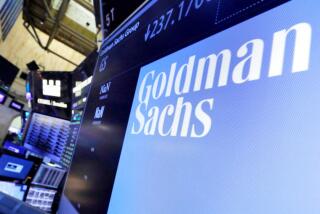Derivatives Sellers Agree to Police Themselves : Investment: Six firms will voluntarily provide regulators with details of their business.
- Share via
WASHINGTON — Hoping to head off a congressional crackdown on derivatives, the six investment banks that dominate sales in the complex field Thursday announced a voluntary agreement to provide federal regulators with detailed information on their trades, risks and customers.
They also proposed to improve their disclosures to their own clients of the risks and nature of the esoteric transactions. Had similar early-warning systems for management been adopted by the supervisors in Orange County or by top officials at the Barings investment bank, the likelihood of those catastrophic financial failures would have been “considerably lower,” speculated E. Gerald Corrigan of Goldman Sachs, chairman of the voluntary industry group and a former president of the Federal Reserve Bank of New York.
Goldman Sachs, as well as Morgan Stanley, CS First Boston, Merrill Lynch, Salomon Bros. and Lehman Bros., will file voluntary reports with the Securities and Exchange Commission and the Commodity Futures Trading Commission. The firms together handle more than 90% of the derivatives business.
*
By agreeing to self-regulation, the firms are clearly hoping to forestall action in Congress to control the use of derivatives, which have been linked to a succession of spectacular financial losses in recent months.
Congress, remembering the $150 billion already spent for the rescue of failed savings and loans, is concerned about the potential disruptive threat of derivatives to banks and S&Ls; insured by the taxpayers and the chances that losses could spread to the financial system in general.
SEC Chairman Arthur Levitt Jr., whose agency helped draft the new rules, said Thursday that self-regulation offers the best approach to managing derivatives risk.
“I have resisted seeking a legislative fix to this problem, partially because, frankly, I would not know precisely what to ask for in that connection,” he told a news conference at which the agreement was made public.
Derivatives are financial instruments whose value is derived from an underlying stock, bond, commodity or financial index. This might be the interest rate on Treasury bills, the Standard & Poor’s 500-stock index or the price of crude oil.
For example, the collapse of the British merchant bank Barings resulted from losses in its immense holdings of futures on the Nikkei-225 index of Japanese stocks; the futures represented a bet that the stocks would rise, and the bank incurred nearly $1 billion in losses when they fell.
What particularly concern regulators and other market experts are so-called over-the-counter derivatives--that is, specialized transactions designed by special departments at the six large firms and others for sale to individual customers or institutional investors.
Because these deals are not easily broken down into futures and options traded on regulated commodity exchanges, their prices and thus their risks can be nearly impossible to fix. That’s especially true when the underlying markets move sharply and unexpectedly, as in a financial crash.
*
Whether the initiatives announced Thursday can minimize that problem is unclear. Although the six major firms said they would rely on their own computer models in estimating their derivatives risks for federal regulators, those models have not always accurately forecast the price behavior of complex derivatives.
When interest rates suddenly shot up in February, 1994, for example, several institutional funds suffered massive losses because their derivatives holdings behaved unpredictably.
Nevertheless, Levitt said Thursday that he hopes the voluntary standards will become universal for derivatives marketers in the United States and will be adopted in other nations to prevent customers from going overseas to seek potentially risky speculative opportunities.
Normally “competitors to the death,” in Corrigan’s words, the six firms agreed to report each quarter their 20 largest derivatives deals, the partners with whom the deals were made and the potential financial risk from each.
The corporate customers involved in these deals will be identified only by code number. But if federal regulators see the same code occurring repeatedly, indicating an unusually large concentration of activity, they can ask for the name of the customer.
Each firm will use a computer model to provide predictions of the maximum loss in the event of market fluctuations. The computer model will consider the impact of wide overnight swings in interest rates, stock index prices and currency exchange rates as it tries to forecast financial exposure.
An independent auditor will provide regular reports to the SEC and Commodity Futures Trading Commission about the firms’ adherence to the new system of controls and reviews.
*
Rosenblatt reported from Washington and Hiltzik from Los Angeles.
More to Read
Inside the business of entertainment
The Wide Shot brings you news, analysis and insights on everything from streaming wars to production — and what it all means for the future.
You may occasionally receive promotional content from the Los Angeles Times.










